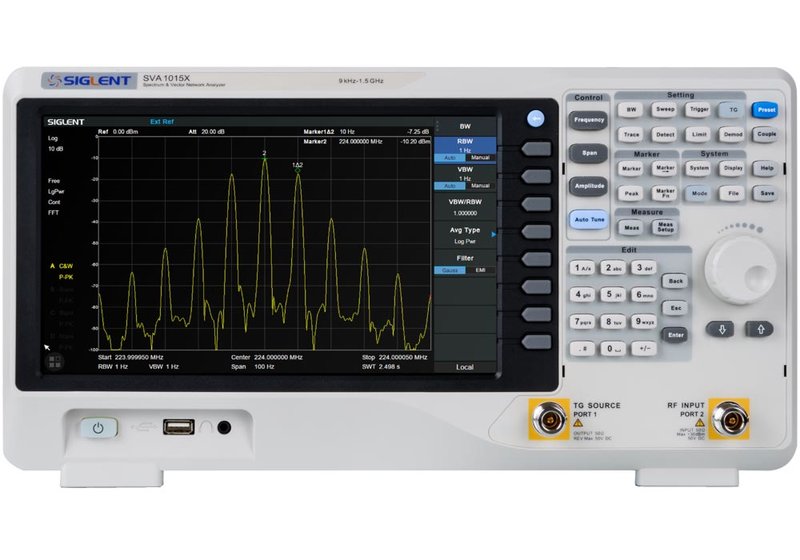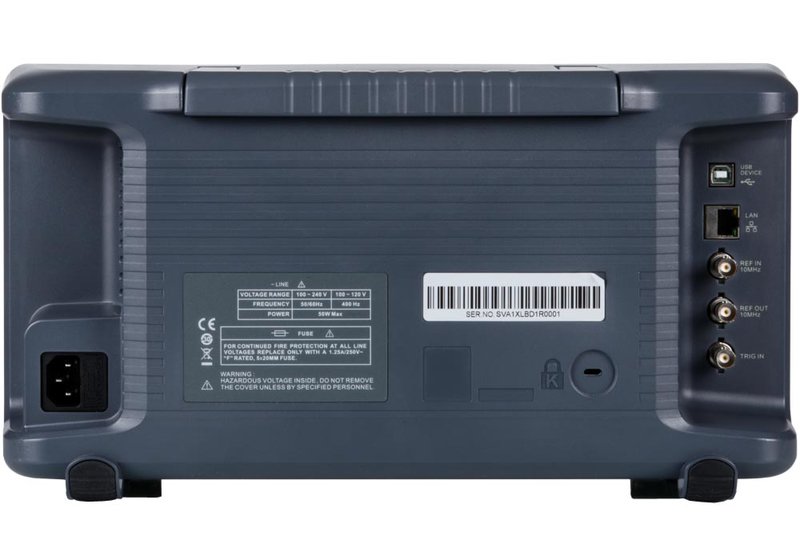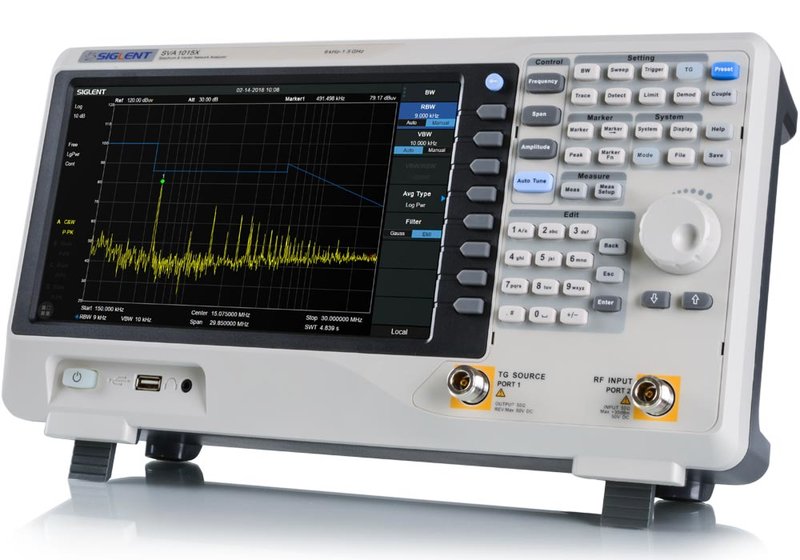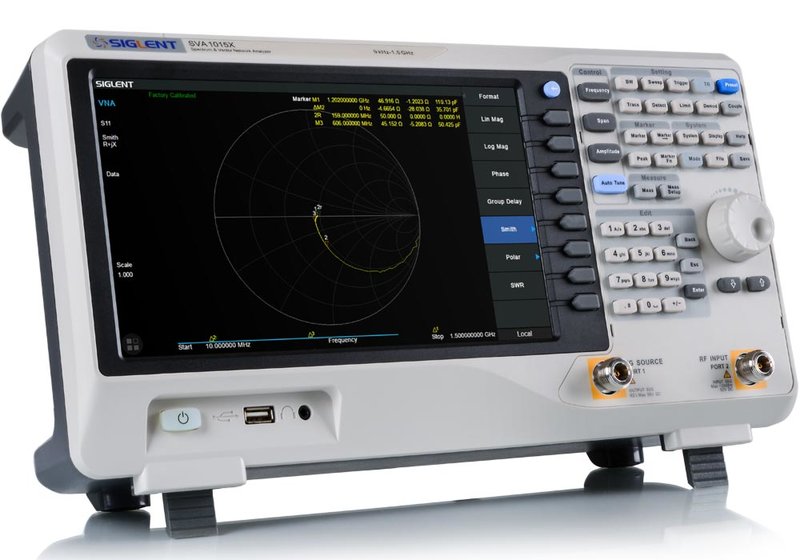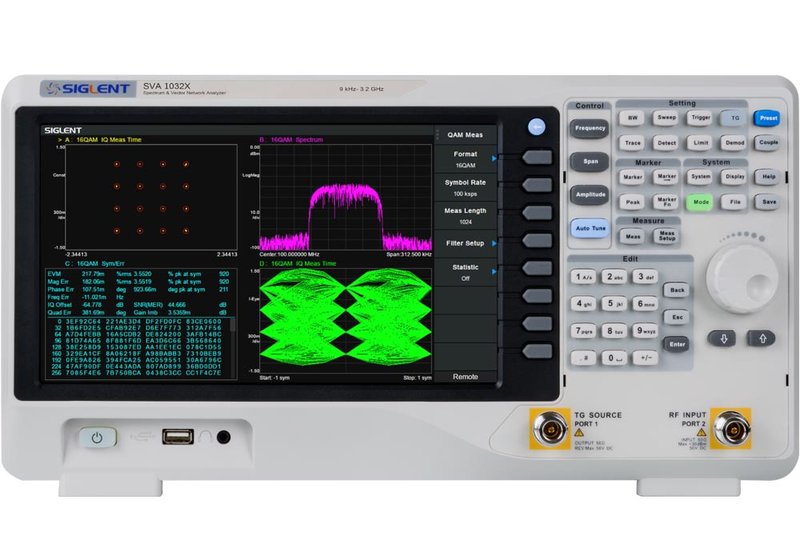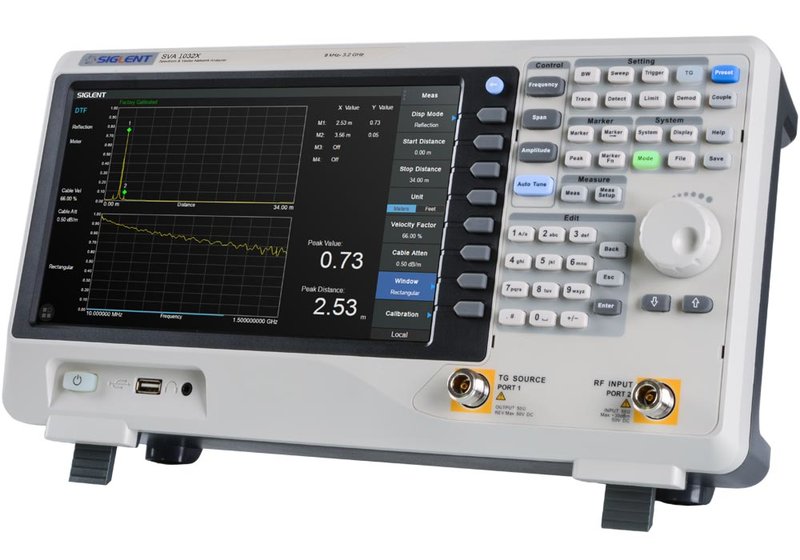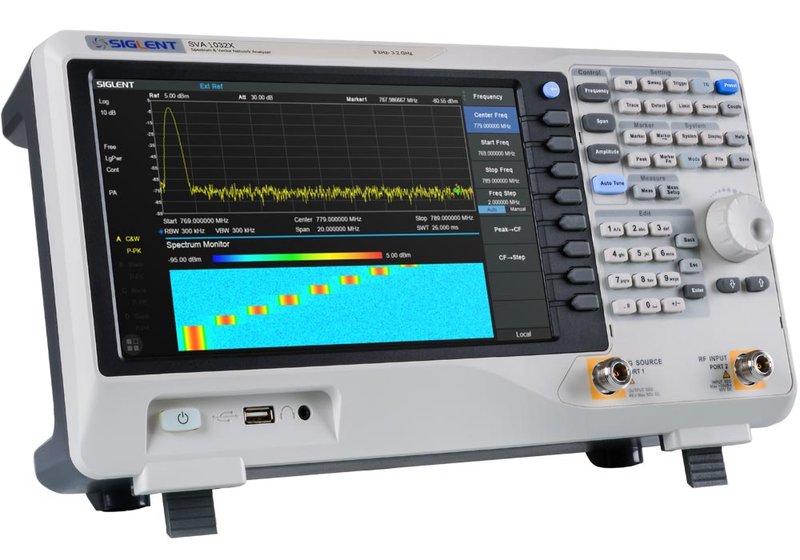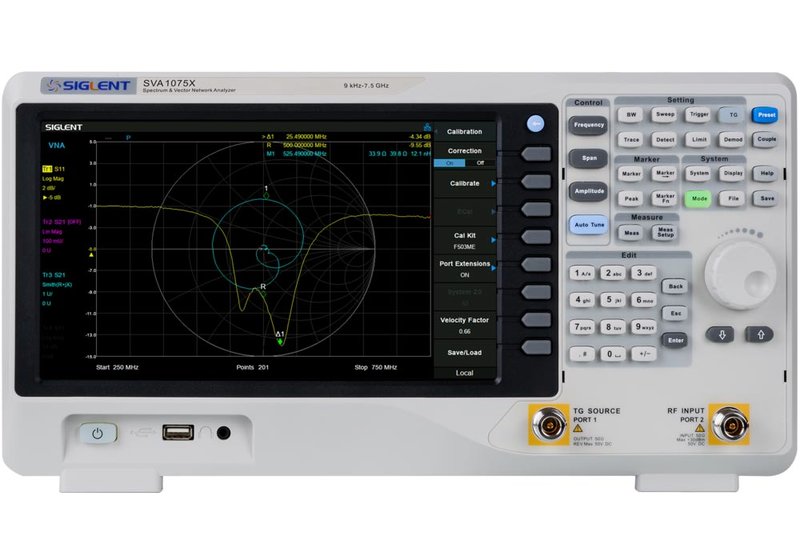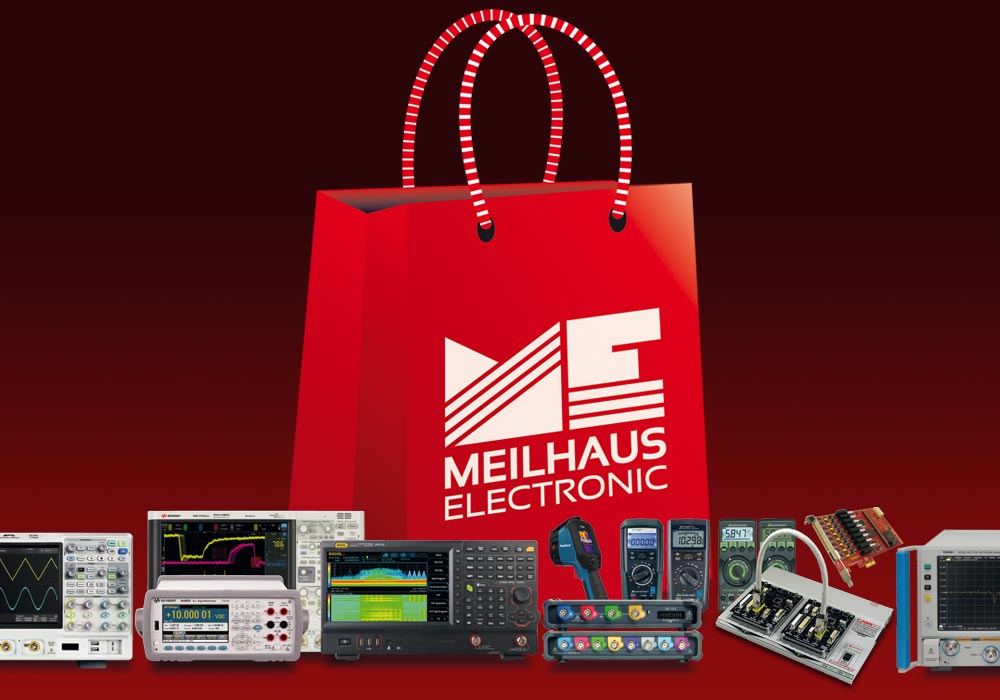Siglent SVA1015X, SVA1032X, SVA1075X Spectrum Analyzer/VNA up to 7.5GHz
Benefits of the Siglent Spektrumanalyzer/VNA SVA1000X Series
- Spectrum analyzer up to 1.5, 3.2, or 7.5 GHz, and vector network analyzer.
- Options: Distance to fault, modulation analysis, EMI pre-compliance testing.
- Bright 25.7 cm multi-touch screen.
Siglent SVA1000X Series Spectrum and Vector Network Analyzer up to 1.5, 3.2, or 7.5 GHz
Models SDS1202X-E, SDS1104X-E, SDS1204X-E
The Sigent SVA1000X series spectrum and vector network analyzers are powerful and flexible tools for broadcast and RF device testing. With a wide frequency range from 9 kHz to 1.5, 3.2, or 7.5 GHz, the analyzer delivers reliable automatic measurements and plenty of features including a tracking generator (standard) and multiple modes of operation: The base model is a swept super-heterodyne spectrum analyzer and vector network analyzer. Available options are a frequency domain reflectometer based distance-to-fault locator and a modulation analyzer. Applications include broadcast monitoring/evaluation, site surveying, EMI pre-compliance (EMI option), research and development, education, production, and maintenance.
- All-digital IF technology.
- Frequency range from 9 kHz to 1.5, 3.2, or 7.5 GHz.
- Vector network analyzer from 10 MHz...1.5 GHz or 100 kHz...3.2 or 7.5 GHz.
- -156, -161, or -165 dBm/Hz DANL (Displayed Average Noise Level, typ.).
- -98 dBc/Hz phase noise (typ.).
- Level measurement uncertainty <1.2 dB or 0.6 dB (typ.).
- 1 Hz...1 MHz or 3 MHz RBW (Resolution Bandwidth).
- Preamplifier standard.
- Tracking generator standard.
- Distance to fault (option).
- Modulation analysis (option).
- EMI pre-compliance test kit (option).
- Advanced measurement kit (option).
- 10.1"/25.7 cm (1024x600) multi-touch screen.
- Mouse and keyboard supported.
- Standard interfaces USB Host and Device, Ethernet/LAN, optional GPIB.
- Web browser remote control on PC and mobile terminals.
Model Overview
| Model | SVA1015X | SVA1032X - NEW! | SVA1075X - NEW! |
| Operating modes | Spectrum analyzer (standard), VNA/vector network analyzer (standard), distance-to-fault (optional), modulation analysis (optional), EMI test (optional) | ||
| Frequency range | 9 kHz...1.5 GHz | 9 kHz...3.2 GHz | 9 kHz...7.5 GHz |
| RBW (resolution bandwidth) | 1 Hz...1 MHz (1-3-10 sequence) | ||
| DANL (displayed average noise level) | typ. -156 dBm/Hz | typ. -161 dBm/Hz | typ. -165 dBm/Hz |
| Phase noise | <-98 dBc/Hz | ||
| Total amplitude precision | <1.2 dB | <0.7 dB | <0.7 dB |
| Preamplifier | Standard, 20 dB (nom.) | ||
| Tracking generator | Standard, 5 MHz...1.5 GHz; RBW 30 Hz...1 MHz (sweep mode) | Standard, 100 kHz...3.2 GHz; RBW 30 Hz...1 MHz (sweep mode) | Standard, 100 kHz...7.5 GHz; RBW 3 kHz...3 MHz (sweep mode) |
| Sweep and trigger | Sweep time 1 ms...3200 ; sweep rule single, continuous; trigger source free, video, external (5 V TTL level, rising edge/falling edge) | ||
| Vector network analysis | S11, S21 measurement, 10 MHz...1.5 GHz | S11, S21 measurement, 100 kHz...2.3 GHz | S11, S21 measurement, 100 kHz...7.5 GHz |
| Dynamic range (typ.) | 60 dB (100 kHz...10 MHz, SVA1032X, 1075X); 90 dB (10 MHz...1.5 GHz, all), 90 dB (1.5...3.2 GHz, SVA1032X, 1075X), 80 dB (3.2...7.5 GHz, SVA1075X) | ||
| Distance to fault | Optional, VNA timing domain analysis, 10 MHz...1.5 GHz; windows: Rectanglar, Hamming | Optional, VNA timing domain analysis, 100 kHz...3.2 GHz; windows: Rectanglar, Hamming | Optional, VNA timing domain analysis, 100 kHz...7.5 GHz; windows: Rectanglar, Hamming |
| Modulation analysis | Optional, AM, FM, ASK, FSK, MSK, PSK, QAM | ||
| Advanced measurement kit | Optional, CHP/channel power, ACPR/adjacent channel power ratio, OBW/occupied bandwidth, CNR/carrier noise ration, time domain power, harmonic, TOI;/third order intercept, QAM | ||
| EMI pre-compliance test kit | Optional, EMI filter and quasi-peak detector,log scale, limit line, EasySpectrum software | ||
| Interfaces | USB Host, USB Device (USB 2.0), mouse/keyboard supported, Ethernet/LAN (VXI-11, 10/100 Base, RJ45), optional GPIB | ||
| Display | TFT LCD, 1024x600 (waveform area 751x501), 10.1"/25.6 cm multi-touch screen | ||
| Dimensions (mm) | 393 x 207 x 117; 4.4 kg | ||
Included: SVA 1015X, 1032X, or 1075X, quick start, power cord, USB cable, calibration certificate.
Frequently Asked Questions:
Question: Which DUTs can a VNA measure?
Answer: Typical DUTs (Devices under Test) for VNA (vector network analyzers) can be for example filters, where input/output impedance, insertion loss, frequency response, group delay, phase, stopband attenuation, etc. are of interest. For RF amplifiers, input/output impedance and frequency response also are measured, plus gain, 1-dB compression, and IP3 (Intercept Point 3, Third Order Intercept Point). For L and C (inductances and capacitances), the S-parameters are determined for simulations. Other typical DUTs for VNA are cables and antennas (impedances, matching, cable test, etc.), mixers and circulators, up to complete subsystems.
Question: Are the Siglent SVA1015X, SVA1032X and SVA1075X full VNA/vector network analyzers?
Answer: VNA are usually priced in much higher regions than the Siglent SVA1000X series instruments. Can they be "real" VNA then? Yes, the SVA1000X devices are "real" VNAs, but with limited features. They offer one fixed-power source and only one receiver. In addition, the dynamic range is about 80 dB as opposed to 100 dB for "full" VNAs. However, there are many applications where this is perfectly adequate and the extra cost of an expensive VNA would not be justified (see next question).
Question: What can be measured with the Siglent SVA1015X, SVA1032X and SVA1075X, what cannot be measured?
Answer: The Siglent SVA1000X series is suitable for measuring the S-parameters/scatter parameters S11/S21 (reflection/transmission), for example for measuring RF components such as filters, amplifiers, cables and antennas. The instruments also measure feedback attenuation/VSWR, insertion loss, phase change, group delay and complex impedance (impedance matching for RF designs).
Unlike "full" VNAs, they can measure the S-parameters S22/S12 only by turning the DUT and recalibration. The power level cannot be adjusted and sweeping of power and offset frequency sweep is not possible. Also, the instruments do not offer a multi-window view.
Question: Why do I need to calibrate the VNA?
Answer: An essential part of an accurate VNA measurement is calibration. Therefore, a VNA should always be purchased with an appropriate calibration kit (see accessories). A common calibration method is the SOLT method (also OSLT; short, open, load, and through). Calibration is performed before each measurement in a new measurement configuration. Calibration eliminates systematic errors in the measurement as far as possible, for example frequency and phase response in the measuring instrument, measurement setup, cables and accessories. These systematic errors are reproducible and always equally present. Therefore, they can be widely compensated by calibration. Additionally occurring random measurement deviations (e.g. noise) cannot be compensated but only statistically detected. Calibration kits are available for different frequency ranges and with different connection types such as N or SMA female/male.
Question: Do the Siglent SVA1015X, SVA1032X and SVA1075X have a touch screen?
Answer: Yes, all models are equipped with a 10.1"/25.6 cm multi-touch screen. USB Host and Device as well as Ethernet/LAN interfaces are standard. GPIB (IEEE488) can be upgraded via an optional USB-to-GPIB adaptor.
Information on product safety:
Manufacturer:
SIGLENT Technologies CO., LTD., Blog No.4 & No.5, Antongda Industrial Zone, 3rd Liuxian Road, Bao’an District, Shenzhen, 518101/CHN
www.siglent.com
(EU branch Germany)
Related Products
Customers also bought






















